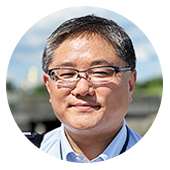A Sun Child is born
The statue is 6.2 meters tall and depicts a child in a yellow protective suit. It was installed in front of a child-rearing support facility in the middle of the city on July 28th. The Sun Child holds a helmet, smiling as he looks into the distance.

It was created by contemporary artist Kenji Yanobe, a professor at the Kyoto University of Art and Design. He said he wanted the boy taking off his helmet and taking a deep breath to show the air in Fukushima is now clean. He said the radiation counter on the boy's chest shows zero to symbolize a world without nuclear disasters, despite the fact that in reality radiation levels never fall to zero because of natural background radiation. Yanobe also said the sun in the boy's right hand represents his hope for the future and the creation of new forms of energy.

The statue was installed on the eve of my last day at NHK's Fukushima bureau. It was put in front of the building next to the bureau, and I saw it for the first time when I was picking up my stuff at the office. It surprised me, but I never imagined it would cause so much controversy.
Controversy flares
The Sun Child was officially unveiled on August 3rd. It is the first of three identical statues by Yanobe. After debuting at Osaka Expo Park in October 2011, the statue was exhibited across Japan. When it was displayed at the Fukushima airport, the response was so positive that the exhibition period was extended.
The statue seemed to have found a permanent home in Fukushima.
But immediately after it was installed, there was controversy. Responses were mixed. City officials received calls from people saying they feared the statue would give the impression that residents of the city had to wear protective suits after the nuclear accident. Others said it could lead to more rumors about the safety of Fukushima. On the other hand, some people said they understood what Yanobe wanted to say, and some said the statue gave them courage.
A survey conducted by the city at the site found 22 respondents were in favor of the statue, while 75 were against. Of the 67 phones calls and messages the city received on the Sun Child, 8 were in favor and 44 were against.
Removal
At first, Fukushima mayor Hiroshi Kohata dismissed the criticism, saying the Sun Child is a symbol of the city's reconstruction. But as the controversy grew, he was forced to change his stance. On August 28th, Kohata announced at a news conference that it was difficult to keep displaying the statue as "a symbol of reconstruction" given the mixed reaction. He said while some residents wanted the statue to stay, many more wanted it gone.

At a city assembly meeting on September 11th, Kohata said he would cut his salary by 10 percent for 3 months to take responsibility for the statue. He pledged to reflect on the failure to build a consensus before the installation, and said it was a lesson in managing municipal government.

Yanobe said at a September 5th press conference that he accepted the city's decision. He added he regretted having rushed to set up the statue without listening to the voices of the people of Fukushima. He said it would be better to discuss the statue after it was removed, given the controversy it had caused.

The Sun Child was dismantled and taken away on September 18th and 19th. It was disassembled into 10 parts before being removed. Some came to take pictures as the process began. A man in his 60s said debate surrounding the statue should not end with the removal. He said citizens need to use this opportunity to discuss how to confront the legacy of the nuclear accident.
City officials say they have no plans for the Sun Child's future.
Yanobe says he is concerned the statue's removal could make other artists cautious of expressing themselves, that they may censor themselves. He says he fears the fate of the Sun Child could make artists think twice before they create work that touches on Fukushima. I felt what happened to the statue highlights the difficulty of expressing the nuclear disaster through art.

Politicization of the Sun Child
I talked to people in Fukushima about the removal and I found that controversy on social media may have complicated the issue and was partly responsible for the removal. One person told me both pro and anti-nuclear activists used the statue for their causes. He told me of a case in which someone ordered peaches, a regional specialty, from a local farmer only to later cancel the order, citing worries caused by the Sun Child. My source suspected it was an elaborate attempt to create an atmosphere where the statue had a sway on dialogue. A few hotels in Fukushima have reportedly received similar cancellation notices.
My source says the impact of the controversy on social media played a role in the statue's removal. He says he felt like he had witnessed the dark side of society.
Artistic expression goes on

Does this mean artists should stay away from the theme of Fukushima? Having covered the story, I agree with Yanobe that artists should not be afraid to express themselves. One thing I frequently heard from people in Fukushima was that they feared the number of people paying attention to the nuclear accident would decline. Their biggest worry is being totally forgotten.
How should artists engage with Fukushima from now on? In his statement on the removal of the statue, Yanobe expressed his determination to stay committed to a dialogue with the people of Fukushima. "I take the removal to heart. I want to have dialogues with as many citizens as possible so as to make a fresh start."

